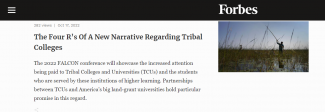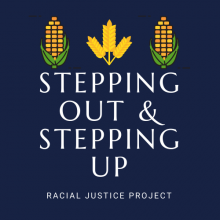
Various calls have been made to pay greater attention to Tribal Colleges and Universities (TCUs) and the students served by these institutions of higher learning. TCU leadership historically has been provided by the American Indian Higher Education Consortium (AIHEC), which notes that “each of these institutions was created and chartered by its own tribal government or the federal government for a specific purpose: to provide higher education opportunities to American Indians through programs that are locally and culturally based, holistic, and supportive.”
TCUs were established as land-grant institutions through the 1994 Equity in Educational Land-Grant Status Act, which is why they sometimes are referred to as the 1994 land-grants. In turn, many Historically Black Colleges and Universities (HBCUs) also are known as the 1890 land-grants owing to the passage of the Morrill Act of 1890. Rounding out the picture, the 1862 Morrill Act gives the predominantly white serving land-grant universities their alternate name: the 1862 land-grants.
Although the 1994, 1890, and 1862 land-grant universities are considered sister institutions, similarities end when resource allocations are taken into account. In general, for every $100 in financial support received by 1862 land-grants, the 1890 land-grants receive about $10, while the 1994 land-grants receive little more than $1. This grossly unequal funding ratio is the reason that these 1862 land-grant universities — including such prominent names as Cornell, Maryland, Michigan State, MIT, Ohio State, Penn State, Rutgers, Texas A&M, West Virginia University, Wisconsin, and the University of California — have been urged to figure out ways to partner with and otherwise bolster the efforts of their 1994 and 1890 counterparts.
The 2022 First Americans Land Grant Consortium (FALCON) conference taking place this week in Albuquerque, New Mexico includes a post-conference day that shines a bright spotlight on activities designed to build and strengthen 1994-1862 partnerships. Supported by grant funding through the National Institute for Food and Agriculture (NIFA is part of USDA) and the North Central Regional Center for Rural Development, over 100 faculty, staff, and students from both the 1994 and 1862 land-grants will be coming together to expand and refine ongoing dialogue about the collaboration of their institutions in the areas of teaching, research, and community engagement.
In this present piece, we take a brief tour of the new narrative that is being developed which helps to drive these 1994-1862 partnership activities. Richard Williams, a member of the Oglala Lakota and Northern Cheyenne Tribes who previously served as the executive director of the American Indian College Fund, describes what might be termed the “Four R’s” of this new narrative: Response, Relationships, Reciprocity, and Reporting.
Response
“First, every 1862 land-grant university must acknowledge the land taken from each Tribal Nation,” Mr. William noted. Here he is referring to the fact that these universities were established through the seizure and sale of Native American territories, something that has been termed the “original sin” of these institutions of higher learning. “This will help educate those Nations that currently do not know about the dishonorable land transactions that affected them. This action also sets the stage for what comes next, which involves creating and building future relationships.”
Relationships
“Second, relationships between 1862 land-grant universities and Tribal Nations must be dedicated to improvements in socioeconomic standing,” Mr. Williams continued. And to best accomplish the task, he went on to say, “the 1862 land-grant must have an agreement with each Tribal College that serves those Tribal Nations, one that incorporates and articulates clear financial support and establishes an advocacy position at the national level for increased financial support of these Tribal Colleges.”
Reciprocity
Third, to sustain and strengthen relationships among these land-grant universities, Tribal Nations, and TCUs, funding strategies based on the principle of reciprocity will be needed. Mr. Williams proposes that “every 1862 land-grant university must assign a portion of the assets from their endowment funds to support and increase access to their institutions for the citizens of Tribal Nations that lost land.” For example, proceeds from the seizure and sale of lands used to establish land-grant universities could be “paid back” through dedicated scholarship programs for Native American students, something that is happening at growing numbers of institutions across the country. Academic pipeline programs that encourage students served by TCUs to continue their educational pursuits at 1862 land-grants also could help round out the picture.
Reporting
Fourth and finally, there will need to be an ongoing accounting of efforts undertaken to make all this happen. “Each 1862 land-grant university must file an annual report noting the progress made toward reconciliation,” said Mr. Williams. He went on to suggest that a yearly site visit to each Tribal Nation also be conducted. “The interaction should not be a consultation. Instead, it must be a demonstrated action supporting the development of the Indian nations.” Again, ongoing partnerships with TCUs will become the force multipliers of such ongoing efforts.
The FALCON post-conference day will feature presenters like Mr. Williams who have been doing much of the early (and heavy) lifting involved at the beginning of these sorts of endeavors. A forthcoming article based on the conference day itself will include quotes and deliberations from these groundbreaking scholars, researchers, and practitioners. Taken together, what is happening among this group is nothing less than a purposeful turning away from an old storyline that had effectively marginalized the TCUs and thus a turning toward a new narrative that promises unlimited possibilities.
https://www.forbes.com/sites/stephengavazzi/2022/10/17/the-four-rs-of-a-new-nar…
